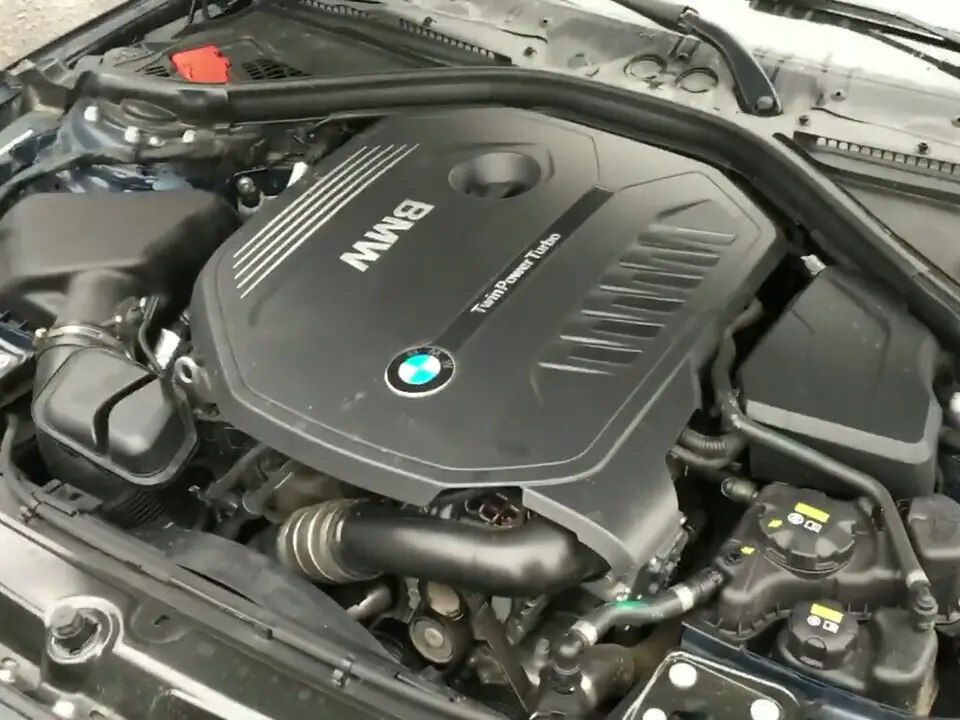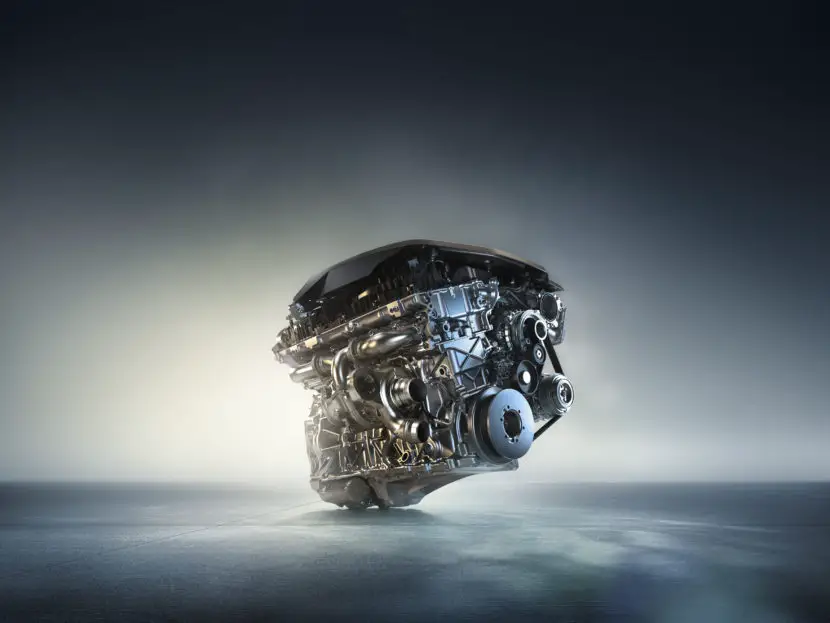The BMW B58 engine is a member of the company’s modular engine family used across much of BMW’s eclectic range since 2015. These new BMW engines were built as a replacement to the previously ubiquitous N55 model, and itself now comes in 7 versions outputting from 321hp to 382hp. The B58 engine is not to be confused with the S58, which is the higher-performance version of the engines, outputting power up to 503hp.
In short, it’s a straight-six 3.0L engine with an 82mm cylinder bore and 94.6mm piston stroke, and one single twin scroll turbocharger. The block is a closed-deck aluminum design and features a 4-valve-per-cylinder DOHC with Valvetronic valvetrain. The redline on its RPM range is 7,000. It’s slightly heavier than the previous N55 model (290lbs), weighing in at 306lbs.
Which BMW Models Have the B58 Engine?
Since 2015, there have been seven models of B58 engine developed, which are used widely across the BMW range. Below is a summary of how each version is applied:
- B58B30M0 (4 models from 2015-2017 to present) – Used in the 7 Series, 4 Series, 3 Series, 1 Series, 2 Series, 5 Series, 6 Series, X3, and X4.
- B58B39M1 (2018 to present) – Used in the X5, X6, X7, Z4, 5 Series, 6 Series, 7 Series, and 8 Series
- B58B30C (2018 to present) – Used in the Toyota Supra
- B58B30O1 (2018 to present) – Used in the Z4, M3, M4, X3 (m40i), X4, and Toyota Supra
The latter three models were all used from 2018, but all 7 models are currently in use across the range described. The S58 high-performance edition came into use in 2019. It should also be noted that the 335-horsepower B58B39M1 Z4 version was only used in models sold in countries that were subject to EU emissions standards)
Is the B58 Reliable?
As with the majority of engines out there, how reliable it is really depends on how well it is maintained over time. If you change the oil at the right times, look after the key components, and book in for service when you should, then it won’t give you any serious problems.
The B58 engine doesn’t require blind faith, however. It has been recognized multiple times since its emergence in 2015. Ward’s 10 Best Engines named it in its list in 2016, 2017, 2019, and 2020 as used in various models. The 2016 award, for example, was for its use in the BMW 3 Series. Others included the BMW M240i, X5, and M340i.
How Much Power Can the B58 Handle?
The four models that make up the first generation of B58s from 2015-2017 (B58B30M0) can output from 322hp (2015 model) to 355hp (2016 model). The subsequent models from 2018 were more powerful, ranging from 335hp to 382hp at 5000-6500rpm.
With a redline at 7,000rpm, the B58 was clearly built to handle a lot of throttle and power. Maximum torque across the models was an impressive 443lb-ft, suggesting that the B58 was not only powerful but provided tremendous acceleration and driving dynamics, too.
To be more precise, the BMW B58 can create a boost of around 8-11psi using its stock ECU. That’s a moderate improvement on the N55 model, which could only handle a 7-10-psi boost. It’s actually quite an underrating — as is common with many stock-specification vehicles — and the B58 is capable of being tuned up to an amazing 23-24psi boost. To achieve that would require significant modification, however.
How Fast is the BMW 340i
As we mentioned above, the BMW 340i carries the B58 engine and was recognized by Ward’s list of best engines in 2016. The BMW 340i has a top speed of 130mph and a 0-60mph time of just 4.9 seconds.
The 3.0L B58 in the BMW 340i model currently delivers 320hp and 330 lb ft of torque. For a car of high-performance standards, the BMW 340i also offers decent fuel efficiency at 21mph in the city, 32mpg on the highway.
Does the B58 Have Forged Internals?
The short answer is yes. Both the crankshaft and the piston connecting rods are forged. As many will understand, this gives the B58 engine a significant advantage in strength when compared to other models, and especially its predecessor, the N55, in which the shaft was cast.
Some may have been disappointed to learn that the pistons and cylinder walls in the B58 remain cast. This seems to be ill-founded, however, since the strength rating of the pistons is still very high. Another important upgrade that this horsepower machine received was a closed-deck block with a brand-new ribbed exhaust system and intake design. Both the N54 and N55 had an open-deck design.
Is the BMW B58 Better than the N55?
Everyone wants to know for sure: Did BMW succeed in improving on the N55 design? Overall, we say yes. As we mentioned above, the addition of forged parts coupled with a closed-deck engine block design added significant strength and durability to the B58. The BMW B58 engine also featured an improved compression ratio of 11.0:1, giving it a greater boost and turbo boost than the N55.
Having said that, it would be wrong to see B58 engines as brand-new. It is in fact an evolution of the N55. It retains much of the N55’s base technology — direct fuel injection, Dual Vanos, Valvetronic systems, etc. — and it’s only thanks to this technology that the B58 was even possible.
One further enhancement include was in heat management. The B58 uses a water-to-air intercooler integrated into the intake plenum. This greatly reduces the amount of charged air between the compressor and the intake.
That’s not to say that B58 engines don’t come without any issues at all. For example, some have reported minor issues with valve cover gaskets, oil filters, and the Vanos solenoids. Though such things are part of many engine’s regular wear and tear, they can’t be ignored. The engine-mounted heat encapsulation system does a lot to curb all manner of engine wear. It’s probably the most efficient model they’ve made when it comes to heat transfer from the combustion chambers to the crankcase.
Nico Demattia writing for the BMW blog described the ride as being like driving “on liquid silk instead of gasoline.” The greater engine weight doesn’t seem to dampen performance, and the driver will notice minimal-to-zero turbo lag. The N55 wasn’t a bad engine. If it were, there’d be no reason to carry so much of its technology to the B58. The B58 engine is, however, its natural and superior successor.
A Brief History of the BMW B58
BMW, short for Bayerische Motoren Werke AG, has a rich heritage of crafting some of the most remarkable engines in the automotive industry. The B58, an inline-six engine, is part of BMW’s new modular engine family, which was introduced in 2015 in the BMW 340i. This innovative powerhouse not only meets strict emission standards but also delivers unprecedented performance levels.
What’s Special about the Inline-Six Configuration?
An inline-six engine, as seen in the BMW B58, stands out due to its perfect primary and secondary mechanical balance. This balance results in smooth operation and less vibration, contributing to the overall longevity of the engine. The BMW B58, with its inline-six configuration, embodies smooth, harmonious power delivery in spades.
The Inner Workings of the BMW B58
The secret to the B58’s success lies in its inner workings. From the unique closed-deck design to the integrated exhaust manifold, every detail has been meticulously planned and executed.
Closed-Deck Design: A Closer Look
The closed-deck design, a standout feature of the B58, provides enhanced engine block rigidity. But what does this mean for the driver? Well, it allows the engine to handle higher cylinder pressures without losing its shape, resulting in improved performance and durability.
The Magic of the Integrated Exhaust Manifold
The integrated exhaust manifold, another feature of the B58 engine, enables quicker turbocharger spooling by reducing the distance exhaust gases travel to the turbocharger. This ingenious solution not only reduces turbo lag but also improves fuel efficiency and emission performance.
BMW B58: The Jewel in BMW’s Crown
The B58 isn’t just an engine; it’s the heart of some of the most revered models in the BMW lineup. Let’s explore the models that have been graced by this engineering marvel.
BMW B58 in the 3 Series
The 3 Series has long been a crowd favorite among BMW enthusiasts, and the inclusion of the B58 engine took its appeal to an entirely new level. With improved performance, fuel efficiency, and smoothness, the 3 Series with a B58 engine under the hood is a joy to drive.
BMW B58 in the 5 Series
The 5 Series, known for its luxury and performance, found a perfect partner in the B58 engine. This combination offers drivers an unrivaled experience in terms of power, smoothness, and drivability.
BMW B58: Performance Statistics
Every gearhead loves numbers. When it comes to the BMW B58 engine, the statistics speak volumes about its stellar performance.
Power Output and Efficiency
The B58 delivers a power output of up to 382 horsepower and 369 lb-ft of torque, offering drivers an exhilarating experience behind the wheel. Despite this formidable power, it still manages to achieve commendable fuel efficiency.
0-60 mph Time
The zero to sixty miles per hour (0-60 mph) time is a common measure of a vehicle’s quickness. With the B58 engine, vehicles like the BMW 340i can reach 60 mph from a standstill in just 4.4 seconds!
The Future of the BMW B58
The B58, a testament to BMW’s innovation and engineering prowess, continues to evolve to meet the demands of the future. With enhancements in power output, fuel efficiency, and emission performance, the future of the B58 engine seems brighter than ever.
Performance Upgrades and Tuning
The B58 is already a powerful engine, but with performance upgrades and tuning, it can achieve even more. From software upgrades to bolt-on parts, there are numerous ways to extract additional performance from this robust engine.
BMW B58: A Step Towards a Greener Future
BMW has always been at the forefront of sustainable motoring. The B58, with its impressive emission performance and fuel efficiency, is a vital part of BMW’s commitment to a greener future.


